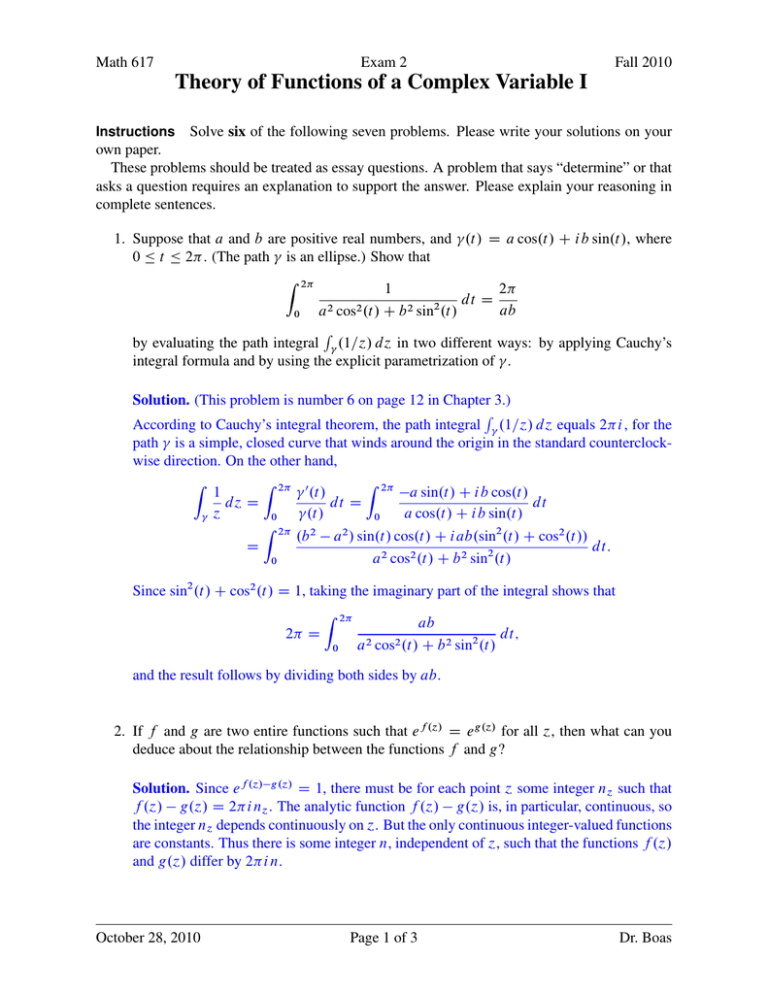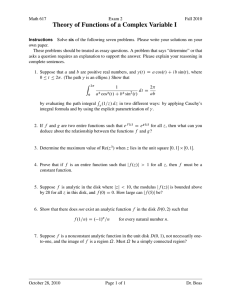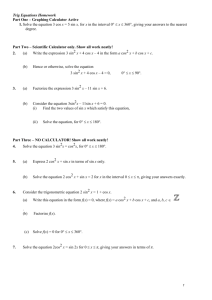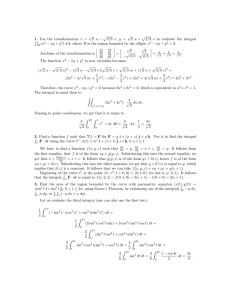Theory of Functions of a Complex Variable I
advertisement

Math 617 Exam 2 Fall 2010 Theory of Functions of a Complex Variable I Instructions Solve six of the following seven problems. Please write your solutions on your own paper. These problems should be treated as essay questions. A problem that says “determine” or that asks a question requires an explanation to support the answer. Please explain your reasoning in complete sentences. 1. Suppose that a and b are positive real numbers, and .t/ D a cos.t/ C ib sin.t/, where 0 t 2. (The path is an ellipse.) Show that Z 2 2 1 dt D 2 ab a2 cos2 .t/ C b 2 sin .t/ 0 R by evaluating the path integral .1=´/ d´ in two different ways: by applying Cauchy’s integral formula and by using the explicit parametrization of . Solution. (This problem is number 6 on page 12 in Chapter 3.) R According to Cauchy’s integral theorem, the path integral .1=´/ d´ equals 2 i , for the path is a simple, closed curve that winds around the origin in the standard counterclockwise direction. On the other hand, Z 2 0 Z 2 Z .t/ a sin.t/ C ib cos.t/ 1 d´ D dt D dt .t/ a cos.t/ C ib sin.t/ 0 0 ´ Z 2 2 .b a2 / sin.t/ cos.t/ C iab.sin2 .t/ C cos2 .t// dt: D a2 cos2 .t/ C b 2 sin2 .t/ 0 Since sin2 .t/ C cos2 .t/ D 1, taking the imaginary part of the integral shows that Z 2 ab 2 D dt; 2 2 a cos .t/ C b 2 sin2 .t/ 0 and the result follows by dividing both sides by ab. 2. If f and g are two entire functions such that e f .´/ D e g.´/ for all ´, then what can you deduce about the relationship between the functions f and g? Solution. Since e f .´/ g.´/ D 1, there must be for each point ´ some integer n´ such that f .´/ g.´/ D 2 i n´ . The analytic function f .´/ g.´/ is, in particular, continuous, so the integer n´ depends continuously on ´. But the only continuous integer-valued functions are constants. Thus there is some integer n, independent of ´, such that the functions f .´/ and g.´/ differ by 2 i n. October 28, 2010 Page 1 of 3 Dr. Boas Math 617 Exam 2 Fall 2010 Theory of Functions of a Complex Variable I 3. Determine the maximum value of Re.´3 / when ´ lies in the unit square Œ0; 1 Œ0; 1. Solution. (This problem is number 23 on page 27 in Chapter 2.) In view of the maximum principle for harmonic functions, it suffices to find the maximum of Re.´3 / when ´ lies on the boundary of the square. On the bottom edge of the square, the value of ´ is a real number varying from 0 to 1, so ´3 also varies from 0 to 1, and the maximum of Re.´3 / equals 1. On the right-hand edge of the square, where ´ D 1 C it and 0 t 1, the real part of ´3 equals 1 3t 2 , which varies from 1 to 2; again the maximum is 1. On the top edge of the square, where ´ D i C t and 0 t 1, the real part of ´3 equals 3t C t 3 , which varies from 0 to 2; the maximum is 0. On the left-hand edge of the square, where ´ is purely imaginary, the values of ´3 are purely imaginary, so the real part is equal to 0. Consequently, the maximum of Re.´3 / on the whole square is equal to 1. 4. Prove that if f is an entire function such that jf .´/j > 1 for all ´, then f must be a constant function. Solution. (This problem is number 13 on page 27 in Chapter 2.) Evidently f never takes the value 0, so 1=f is an entire function. Moreover, the hypothesis implies that 1=f has modulus bounded above by 1. By Liouville’s theorem, the bounded entire function 1=f must be constant, so f must be constant too. 5. Suppose f is analytic in the disk where j´j < 10, the modulus jf .´/j is bounded above by 28 for all ´ in this disk, and f .0/ D 0. How large can jf .5/j be? Solution. Define a function g as follows: g.´/ D f .10´/ 28 when j´j < 1. Then g is analytic in the unit disk, g.0/ D 0, and jg.´/j 1 when j´j < 1. By the Schwarz lemma, jg.´/j j´j when j´j < 1. Consequently, jf .5/j D j28g.1=2/j 28=2 D 14: The upper bound 14 cannot be improved, for this bound is attained when f .´/ D 14´=5. 6. Show that there does not exist an analytic function f in the disk D.0; 2/ such that f .1=n/ D . 1/n =n October 28, 2010 for every natural number n. Page 2 of 3 Dr. Boas Math 617 Exam 2 Fall 2010 Theory of Functions of a Complex Variable I Solution. Seeking a contradiction, suppose that such a function f does exist. Taking n to be even shows that the function f .´/ and the function ´ take the same value at the point 1=.2k/ when k is a natural number. This sequence of points accumulates at the center of the disk, so by the identity theorem, the function f .´/ must be identically equal to the function ´. On the other hand, the function f .´/ matches the function ´ at the point 1=.2k C 1/ for each natural number k, so the identity theorem implies that f .´/ must be identically equal to ´. Contradiction. 7. Suppose f is a nonconstant analytic function in the unit disk D.0; 1/, not necessarily oneto-one, and the image of f is a region ˝. Must ˝ be a simply connected region? Solution. If f is not one-to-one, then the image region ˝ need not be simply connected. For example, suppose f .´/ D exp.8i´/. Then the restriction of f to the interval Œ0; =4 of the real axis defines a simple, closed curve whose trace (image) is the unit circle C.0; 1/. But 0 is a point outside ˝ (since the exponential function never takes the value 0). Thus the region ˝ contains a closed path that has nonzero winding number around a certain point outside ˝, so ˝ is not simply connected. October 28, 2010 Page 3 of 3 Dr. Boas







